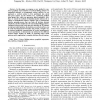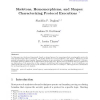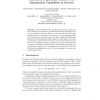102
Voted
PR
2007
15 years 4 days ago
2007
Many algorithms suppress skeleton associated with boundary perturbation by preventing their formation or by costly branch pruning. This work proposes a novel concept of structural...
130
Voted
IJCV
2002
15 years 10 days ago
2002
In an effort to articulate models for the intuitive representation and manipulation of 2D and 3D forms, Blum (1967, 1973) invented the notion of a skeleton. His insight was to con...
105
click to vote
CVGIP
2004
15 years 15 days ago
2004
In this article a novel algorithm is presented for 2D shape interpolation using the intrinsic shape parameters of a piecewise linear curve. The skeletons of two given shapes are c...
125
Voted
VC
2008
15 years 16 days ago
2008
Abstract Mesh partitioning and skeletonisation are fundamental for many computer graphics and animation techniques. Because of the close link between an object's skeleton and ...
115
click to vote
TMI
2008
15 years 16 days ago
2008
Abstract-- In this paper, we propose a new method to construct graphical representations of cortical folding patterns by computing skeletons on triangulated cortical surfaces. In o...
114
Voted
PC
2006
15 years 17 days ago
2006
Trees are important datatypes that are often used in representing structured data such as XML. Though trees are widely used in sequential programming, it is hard to write efficien...
93
Voted
PPL
2008
15 years 18 days ago
2008
Algorithmic skeletons intend to simplify parallel programming by providing a higher abstraction compared to the usual message passing. Task and data parallel skeletons can be dist...
107
click to vote
ENTCS
2007
15 years 18 days ago
2007
In this paper we develop a framework, based on strand spaces, for reasoning about cryptographic protocols and characterizing their executions. We define skeletons, homomorphisms,...
103
click to vote
EUROPAR
2010
Springer
15 years 1 months ago
2010
Springer
Abstract. Algorithmic Skeletons offer high-level abstractions for parallel programming based on recurrent parallelism patterns. Patterns can be combined and nested into more comple...
108
click to vote
EUROPAR
2010
Springer
15 years 1 months ago
2010
Springer
Abstract. To resolve difficulties in parallel programming, a large number of studies are conducted on parallel skeletons and optimization theorems over skeleton programs. However, ...




